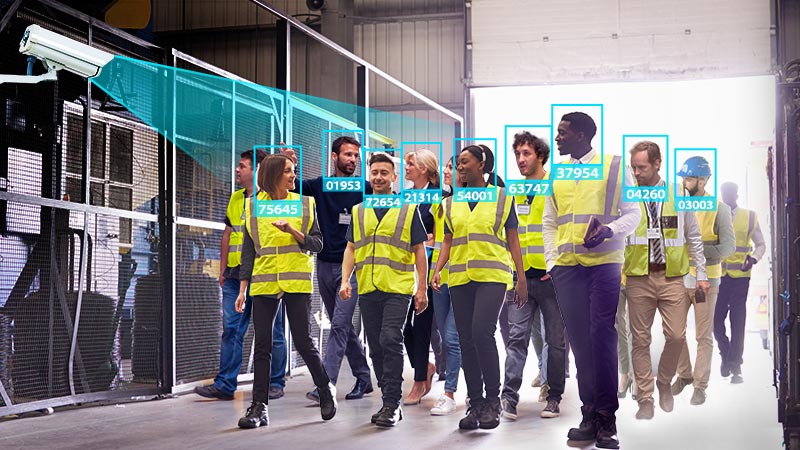3 Ways Facial Recognition can be Utilized in Smart Logistics and Warehousing

A recent market research report published by TBRC asserts that the global warehousing market will grow from US$660 billion in 2022 to US$715 billion in 2023, an increase representing a compound annual growth rate (CAGR) of 8.2%. Moreover, the market is expected to continue to surge to an estimated US$951 billion by 2027.
As this vital service to trade and commerce grows, companies are investing heavily in smart logistics and warehousing operations optimization to maximize efficiency and profitability. In the US alone it is estimated that $40 billion has been spent in a single year to improve logistics operations security.
One technology that produces clear advantages in manufacturing and production operations, business operations and management, and in business-model decision making is AI (artificial intelligence). With a recent Deloitte survey suggesting a significant majority of companies (83%) think AI has made or will make a practical and visible impact in their businesses, it is suggested that “the future is now,” for businesses who move ahead with AI projects.
What is Smart Logistics?
Smart logistics uses AI, big data, and deep learning on neural networks, to optimize the path of manufactured products from the factory or warehouse to the end customer. Logistics is an intricate business, and the increasingly global nature of the marketplace, with the multitude of variables to consider, adds layers upon layers of complexity.
Top Benefits of Implementing Smart Logistics
Smart logistics implementations leverage new technologies like AI facial recognition technology to streamline the full gamut of operations carried out between goods leaving their origination site, to their destination with the end user. With a modern smart logistics solution in place, and with AIoT monitoring of the whole process, businesses can benefit from improved transport efficiency, better stock control, and integration with automated handling equipment or robots in the supply chain.
Below we will look at where AI facial recognition can play a vital role in smart logistics solutions. Specifically, how facial recognition works to provide product security and on-site access control restrictions, operations tracking, and frictionless authentication of staff in the supply chain.
Three Smart Logistics Processes Enhanced by Facial Recognition Technology
#1 Perimeter security and access control
Factories and warehouses often contain valuable goods and resources that require constant monitoring and restricted access to authorized personnel. Facial recognition can play a pivotal role in transforming factory safety and security.
A facial recognition security solution like FaceMe® Security can be added to most existing video management systems. When connected to a database of enrolled individuals, it identifies employees, registered visitors, contractors, and block-listed individuals. In addition to keeping detailed logs, the system sends instant alerts to security personnel if needed. This solution provides automated monitoring, eliminating the need for security staff to sit at a console and manually watch multiple monitors, freeing them to handle any alert quickly – improving security while lowering costs.
#2 Operations tracking
Monitoring operations and executing complex workflows are among the top priorities of manufacturing and warehousing organizations. Facial recognition can streamline several employee processes, such as time & attendance, and machinery and equipment operations.
Facial authentication systems can also keep logs to ensure that only authorized employees are operating equipment, or conducting product inspections, sending alerts if someone violates occupational health and safety standards.
Toyota Motor Corporation adopts ITOCHU Techno-Solutions’ “Vehicle Inspection Information System” integrated with FaceMe Facial Recognition to ensure only certified technicians are allowed to conduct vehicle checks. This further prevents staff from generating fake quality check reports. With FaceMe, Toyota Motor Corporation can enjoy smoother operations, lower costs, and reduced dependence on human monitoring and interventions.
#3 Frictionless Authentication
Factory and warehouse employees authenticate their identity using devices that typically require physical interaction. Clocking-in/out, unlocking doors, and signing on to shared computers, devices, or machinery are all activities that use touchpads, cards, keys, or password entries.
Traditional access control methods slow the movement of employees, as they fumble for a key or card, or type a password. Furthermore, key and card-based access systems cause disruption if these tokens are left behind, lost, or even stolen – and infrequently used passwords are easily forgotten. Some businesses have also observed that employees will use physical access paraphernalia, or passwords, that have been borrowed from another employee.
Employee time and attendance management and access control powered by AI-based facial recognition can streamline the flow of employees, and increase security, by removing the need for physical access tokens and / or passwords. Solutions like CyberLink’s FaceMe neatly sidesteps all the pitfalls of traditional authentication methods mentioned above.
Additionally, there are some compelling benefits to this modern biometric solution you might not have thought of. For example, FaceMe, can perform highly accurate facial recognition even when employees wear protective safety gear such as helmets or masks.
Another benefit of facial recognition technology is that, unlike fingerprint recognition solutions, these camera-based systems don’t require employees to remove gloves, or physically touch any ID sensors.
AI facialp recognition’s role in digital transformation
Thanks to the growth in popularity and proliferation of AIoT and edge devices, more businesses are evaluating and rolling out AI applications. Different industries are utilizing facial recognition to help streamline their operations while strengthening their security management.
Organizations with facial recognition technologies already successfully applied to popular functions like factory safety, security, and access control – are also realizing benefits of the wider application of AI.
Current industry trends suggest that AIoT, automation, blockchain technology, and computer-aided Transportation Management Systems (TMS) are all growth areas, helping to digitally transform businesses and drive efficiencies.
Source : cyberlink.com



